What does 'Check signal cable' mean on my Samsung Flat Panel TV?
- JJoanna PorterSep 23, 2025
If you see a 'Check signal cable' message on your Samsung Flat Panel TV, ensure that the signal cable is firmly connected to the PC source.

What does 'Check signal cable' mean on my Samsung Flat Panel TV?
If you see a 'Check signal cable' message on your Samsung Flat Panel TV, ensure that the signal cable is firmly connected to the PC source.
Why is the picture rolling vertically on my Samsung Flat Panel TV?
If the picture on your Samsung Flat Panel TV rolls vertically, check all wire connections.
Why is there no sound or very low sound on my Samsung LN-T4061F?
If there is no sound or the sound is too low on your Samsung LCD TV even at maximum volume, first check the volume of the devices connected to your TV, such as a digital broadcasting receiver, DVD player, cable broadcasting receiver, or VCR. Then, adjust the TV volume accordingly.
What does 'Check signal cable' mean on Samsung LCD TV?
If you see a “Check signal cable” message on your Samsung LCD TV, ensure that the signal cable is firmly connected to the PC source.
How to fix horizontal bars flickering on Samsung LN-T4061F?
If you are seeing horizontal bars that flicker, jitter, or shimmer on the image of your Samsung LCD TV, adjust the Coarse tuning and then adjust the Fine tuning.
How to fix vertical bars flickering on Samsung LN-T4061F?
If you are seeing vertical bars that flicker, jitter, or shimmer on the image of your Samsung LCD TV, adjust the Coarse tuning and then adjust the Fine tuning.
Why is my Samsung LN-T4061F screen black with a blinking power light?
If your Samsung LCD TV screen is black and the power indicator light blinks steadily, check the power and signal cable on your computer. Also, try moving the computer's mouse or pressing any key on the keyboard.
What to do if my Samsung Flat Panel TV has no picture or sound?
If your Samsung Flat Panel TV has no picture or sound, try switching to another channel. Also, press the SOURCE button to ensure the correct input is selected. Verify that the TV is properly plugged into a working electrical outlet and check the antenna connections to ensure they are secure.
How to fix a malfunctioning remote control for Samsung Flat Panel TV?
If the remote control for your Samsung Flat Panel TV is not working properly, try these steps: * Replace the batteries in the remote. * Clean the transmission window (upper edge) of the remote. * Check the battery terminals to ensure they are properly aligned.
How to improve poor picture quality on Samsung Flat Panel TV?
If you are experiencing a poor picture quality on your Samsung Flat Panel TV, try switching to another channel. Additionally, adjust the antenna to optimize signal reception and check all wire connections to ensure they are properly connected.
| Screen Size | 40 inches |
|---|---|
| Resolution | 1920 x 1080 |
| Display Type | LCD |
| Aspect Ratio | 16:9 |
| Contrast Ratio | 3000:1 |
| Dynamic Contrast Ratio | 15000:1 |
| Brightness | 500 cd/m² |
| Response Time | 8 ms |
| HDMI Inputs | 3 |
| HDMI Ports | 3 |
| Component Inputs | 2 |
| Composite Inputs | 1 |
| Audio Output | 10W x 2 |
| S-Video Input | 1 |
| PC Input | 1 |
| Speakers | 2 |
| Tuner | ATSC/NTSC |
| Viewing Angle | 178° |
Advises on preventing screen burn-in from static images and potential damage.
Outlines the TV's capabilities and technologies.
Lists the items provided with the TV.
Describes the function of each button on the TV's control panel.
Instructions for connecting different types of antennas.
Guidance for connecting multiple antennas.
Steps for connecting cable TV directly to the TV.
Instructions for connecting cable TV with a set-top box.
How to connect a VCR using video or S-Video inputs.
Connecting DVD players and set-top boxes to the TV.
Connecting a camcorder to the TV's side panel.
Connecting external digital audio devices to the TV.
How to connect and use the TV as a computer monitor.
Instructions for powering the TV on and off.
Automatic setup process for new TVs.
How to navigate and select TV channels.
Explanation of specific buttons for channel selection.
Controls for adjusting the TV's audio volume.
Accessing on-screen status and settings.
Navigating the TV's on-screen menus.
Steps to store available TV channels.
Choosing the input source for channel scanning.
Programming the remote to control a VCR.
Programming the remote to control a cable box.
Choosing which connected device to view.
Customizing the names of input sources for easier selection.
Applying preset picture modes (Dynamic, Standard, Movie).
Fine-tuning picture colors according to user preference.
Controlling the screen's backlight brightness.
Accessing advanced picture options for fine-tuning.
Adjusting the depth of black in the picture.
Optimizing the screen's contrast ratio for better viewing.
Adjusting the picture's mid-tone brightness.
Adjusting the color matrix (RGB) for natural tones.
Fine-tuning the color temperature of the picture.
Personalizing specific color adjustments.
Emphasizing picture detail and boundaries.
Enhancing color reproduction for video content.
Enhancing color saturation and clarity for vivid pictures.
Utilizing Samsung's Digital Natural Image engine for better visuals.
Pausing a moving image on the screen.
Optimizing picture settings for movie content.
Adjusting the black level for HDMI input sources.
Enabling the display of two video sources simultaneously.
Selecting the source for the Picture-in-Picture window.
Adjusting the location of the Picture-in-Picture window.
Adjusting the dimensions of the Picture-in-Picture window.
Personalizing audio output settings for user preference.
Applying preset sound modes (Standard, Music, Movie, Speech).
Enabling virtual surround sound for enhanced audio.
Selecting audio language tracks for digital TV broadcasts.
Selecting audio language tracks for analog TV broadcasts.
Equalizing volume levels from different broadcasters.
Muting the TV's internal speakers.
Customizing the sound played when powering the TV on or off.
Restoring default sound configurations to factory settings.
Using headphones for private listening.
Choosing the audio source for the Picture-in-Picture display.
Choosing the correct antenna input source (Air or Cable).
Removing unscanned digital channels from the list.
Adding, deleting, or organizing channels for display.
Assigning custom names to channels for easy identification.
Improving signal reception quality by boosting the incoming signal.
Optimizing reception for analog channels.
Assessing the quality of digital signals for optimal viewing.
Connecting and setting up the TV for PC use.
Selecting optimal display modes for PC signals.
Automatically adjusting PC display settings for optimal clarity.
Improving clarity and reducing noise for PC input.
Adjusting the layout and position of the PC display.
Resetting PC display settings to factory defaults.
Enhancing PC visuals for media playback.
Manually setting the TV's clock time and date.
Scheduling the TV's power on and off times.
Changing the language of the on-screen menus.
Optimizing display settings for gaming consoles.
Controlling the display when no signal is present.
Adjusting the opacity of menu screens.
Reducing power consumption by adjusting TV brightness.
Reducing picture noise and ghosting on weak signals.
Accessing on-screen help for menu functions.
Establishing a PIN for V-Chip security and settings.
Activating or deactivating the V-Chip content blocking feature.
Setting restrictions based on TV rating systems.
Controlling the front panel LED indicator's behavior.
Updating the TV's firmware via USB drive.
Introduction to viewing media files from a USB device.
Browsing and viewing photo files stored on USB.
Adjusting the pace of photo slide shows.
Enabling or disabling background music during slide shows.
Configuring whether music files repeat playback.
Adjusting the screen saver activation time.
Initial setup for the Anynet+ system.
Setting connected devices to power off automatically with the TV.
Finding and selecting connected Anynet+ devices.
Routing TV audio output through a home theater system.
Resolving problems related to the Anynet+ feature.
Step-by-step guide for attaching the TV's base stand.
Instructions for safely removing the TV's base stand.
Adjusting the TV's position after wall mount installation.
Powering the TV on/off and navigating on-screen menus.
Storing available TV channels automatically.
Setting antenna input and managing channel lists.
Selecting preset picture modes for optimal viewing.
Fine-tuning picture settings for personalized preferences.
Choosing the active video input source.
Solutions for frequently encountered TV problems.

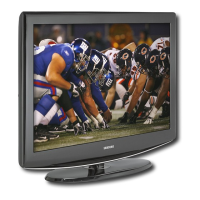
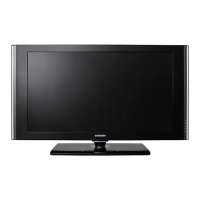
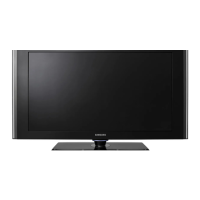
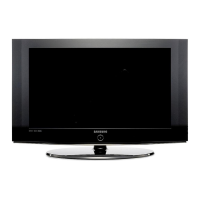
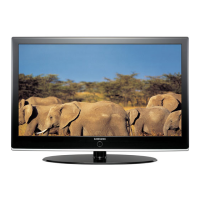



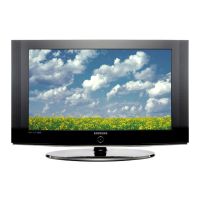

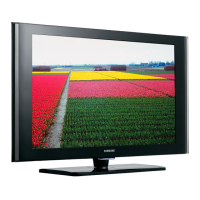
